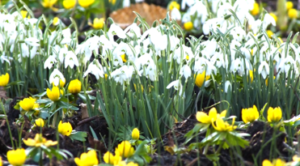Nature Notes – February 2024
by Andy Johnston
At the end of the last Ice Age much of England was covered by an ice sheet between two and three kilometres thick. Over the millennia the ice melted, and a huge glacial lake formed stretching in extent from modern day Kiplin Hall to Cambridge! The initial lake level extended from Leases Lane in the west to Bramper Lane in the east. Thus, the land on which Scruton now stands was under water. The lake level then dropped to a shoreline that pretty much follows Fleetham Lane and Scruton emerged as an island. Over time the lake became infilled with grave sand and glacial clays.
Standing at the junction of Fence Dyke and Fleetham Lanes and looking north, it isn’t difficult to imagine a lake, especially given the current flooded nature of the fields. Scruton stands above the highest flood level, however without the embankments it could be a different matter.
 There are definite signs of Spring; on the Green aconites and snowdrops are in full flower and daffodils well on their way. On sunny days, the paired rooks are fighting over nesting sites in the limes and will soon start building. An oystercatcher was seen at Morton Flatts and a shelduck on flood land adjacent to Fleetham Lane. Song and mistle thrushes are beginning to sing, and at long last daylight is extending. Hooray!!
There are definite signs of Spring; on the Green aconites and snowdrops are in full flower and daffodils well on their way. On sunny days, the paired rooks are fighting over nesting sites in the limes and will soon start building. An oystercatcher was seen at Morton Flatts and a shelduck on flood land adjacent to Fleetham Lane. Song and mistle thrushes are beginning to sing, and at long last daylight is extending. Hooray!!
